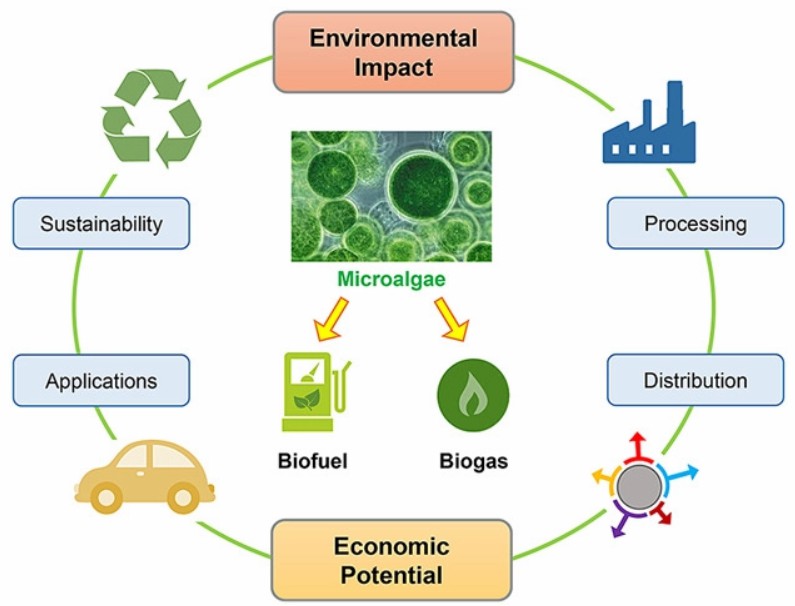Environmental Science and Renewable Energy
In the last two centuries, it has become very difficult to maintain sustainability in terms of environmental protection. Population explosion, rapid urbanization and industrialization, modernization of agriculture, and increasing automobile emissions have led to environmental damage. Various methods using physical, chemical, and biological tools have been and are being developed to minimize the impact of waste generation.
Algae and Environmental Sustainability
Among the various methods of environmental remediation, the most interesting are bioremediation methods using microalgae or macroalgae, which use organisms to achieve bio-transformation processes through metabolic uptake, accumulation, including mainly the fixation of carbon dioxide, or the removal of toxic and non-toxic substances from waste.
 Fig.1 Microalgae and environmental sustainability. (Chia, S. R., et al., 2018, Biotechnology journal)
Fig.1 Microalgae and environmental sustainability. (Chia, S. R., et al., 2018, Biotechnology journal)
Types of Waste and Their Effects
A large amount of waste is generated globally every year, a relatively small portion of which is recycled, and most of which is dumped or left untreated, creating a cascade of problems for people and the environment. Waste can be divided into three types, including solid, liquid, and gaseous waste. Solid waste is commonly referred to as garbage. Disposal measures such as source reduction, waste minimization, recycling, incineration, and landfills can lead to significant pollution. Liquid wastes, which typically include domestic wastewater, agricultural runoff water, and wastewater discharged from industrial processes. Gas waste consists mainly of greenhouse gases such as carbon dioxide, methane, and CFCs, in addition to nitrogen oxides, sulfur oxides, and carbon monoxide.
Wastewater Treatment by Algae
Algae are used in the treatment of many kinds of wastewater, such as domestic and industrial wastewater.
- Domestic Wastewater
Untreated domestic wastewater is an ideal medium for microalgal growth because it contains high concentrations of all essential nutrients such as organic carbon, ammonia nitrogen, nitrate nitrogen, and phosphorus, which offers a wide scope for better water recycling as well as effective biomass generation. - Industrial Wastewater
Industrial wastewater includes wastewater from a variety of industries, such as the textile/dyeing, mining/metallurgy, food, tanneries/chemical, dairy, paper/pulp, and pharmaceutical industries. Depending on the composition of the effluent, different strains of algae are used for targeted effluent treatment.
Atmospheric Pollution Treatment by Algae
Industrialization and the growing demand for transportation have led to massive greenhouse gas emissions, especially carbon dioxide, which in turn have led to a rise in global temperatures. Microalgae are widely used for industrial waste gas treatment and carbon fixation due to their advantages of efficient photosynthesis, faster proliferation rate, and wider tolerance to extreme environments than plants, as well as the potential for intensive culture techniques.
Biofuel Production by Algae
Due to the depletion of fossil fuels, some oilseed crops, and other food crops, as first-generation biofuels, are potential renewable and carbon-neutral alternatives to petroleum fuels. Microalgae are now also being used for biofuel production. The oil production of many microalgae greatly exceeds that of high-yielding crops. In addition, microalgae can provide several different types of renewable biofuels, such as methane, biodiesel, biohydrogen, bioethanol, and biobutanol.
Algae-Based Biosensor for Environmental Monitoring
New potentially harmful compounds are being released into the environment every day. In this context, algal biosensors provide an economically feasible and widely applicable method of potential environmental detection because they can detect the cumulative toxicity of mixtures of known and unknown chemicals in a sample, allowing direct insight into environmental contamination.
Our Services
As an expert in algae research, Lifeasible can provide high-quality algae isolation and culture services, algae engineering services, algae analysis services, algae genetic screening services, algae-based production services, algae monitoring services, algae treatment services, and algae-based biosensor services for environmental monitoring. Please contact us for more information.
Reference
- Chia, S. R., Chew, K. W., Show, P. L., Yap, Y. J., Ong, H. C., Ling, T. C., & Chang, J. S. (2018). Analysis of economic and environmental aspects of microalgae biorefinery for biofuels production: a review. Biotechnology journal, 13 (6), 1700618.
Our services are for research use only and not for any clinical use.